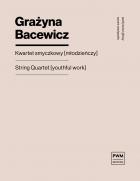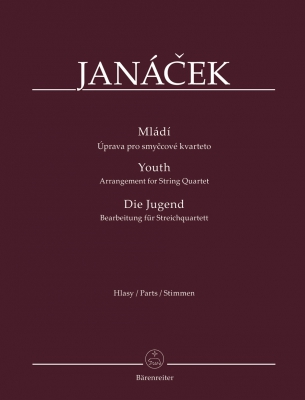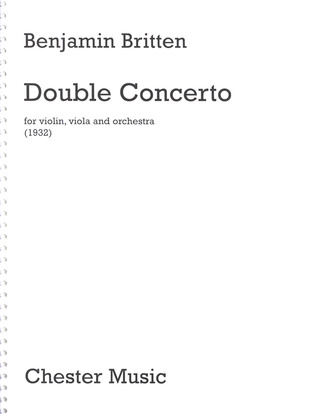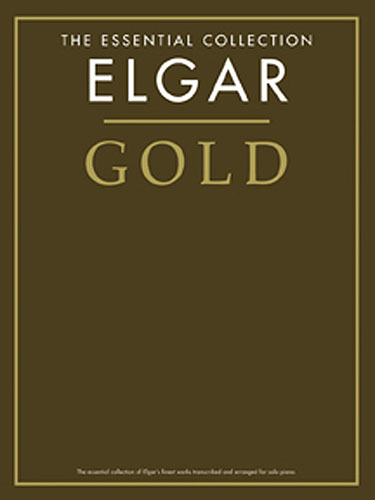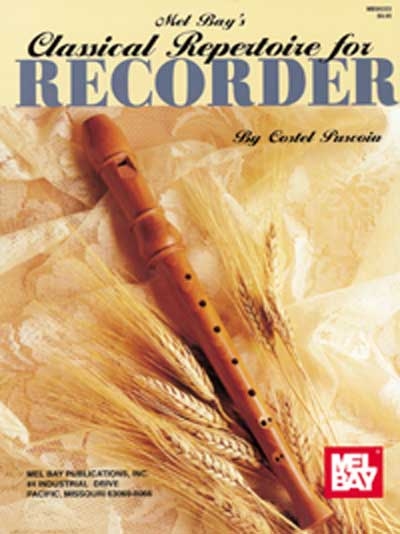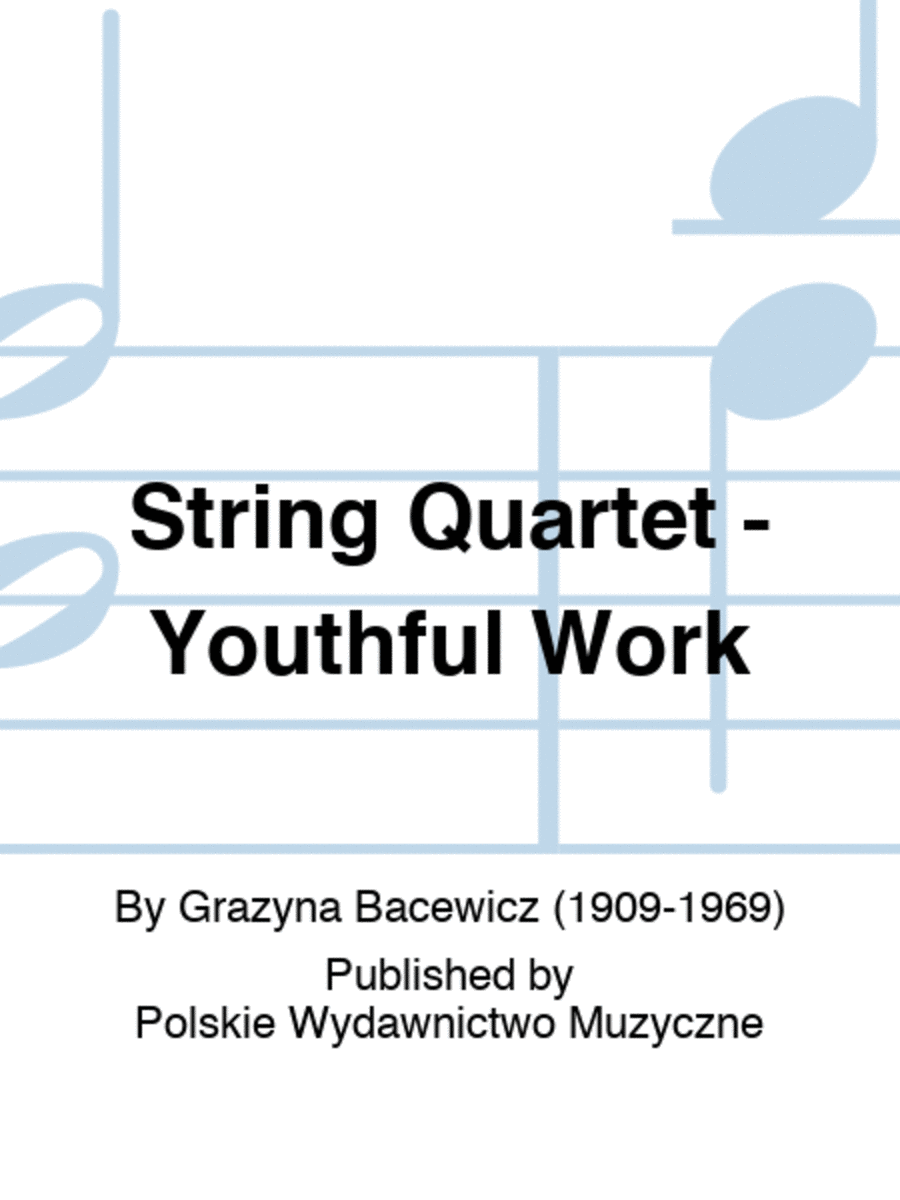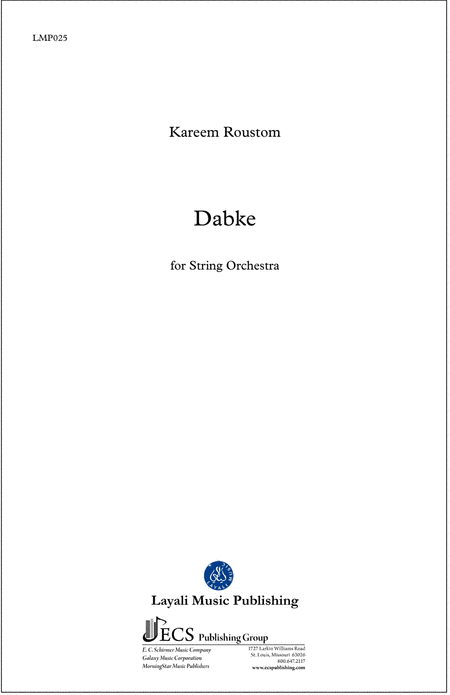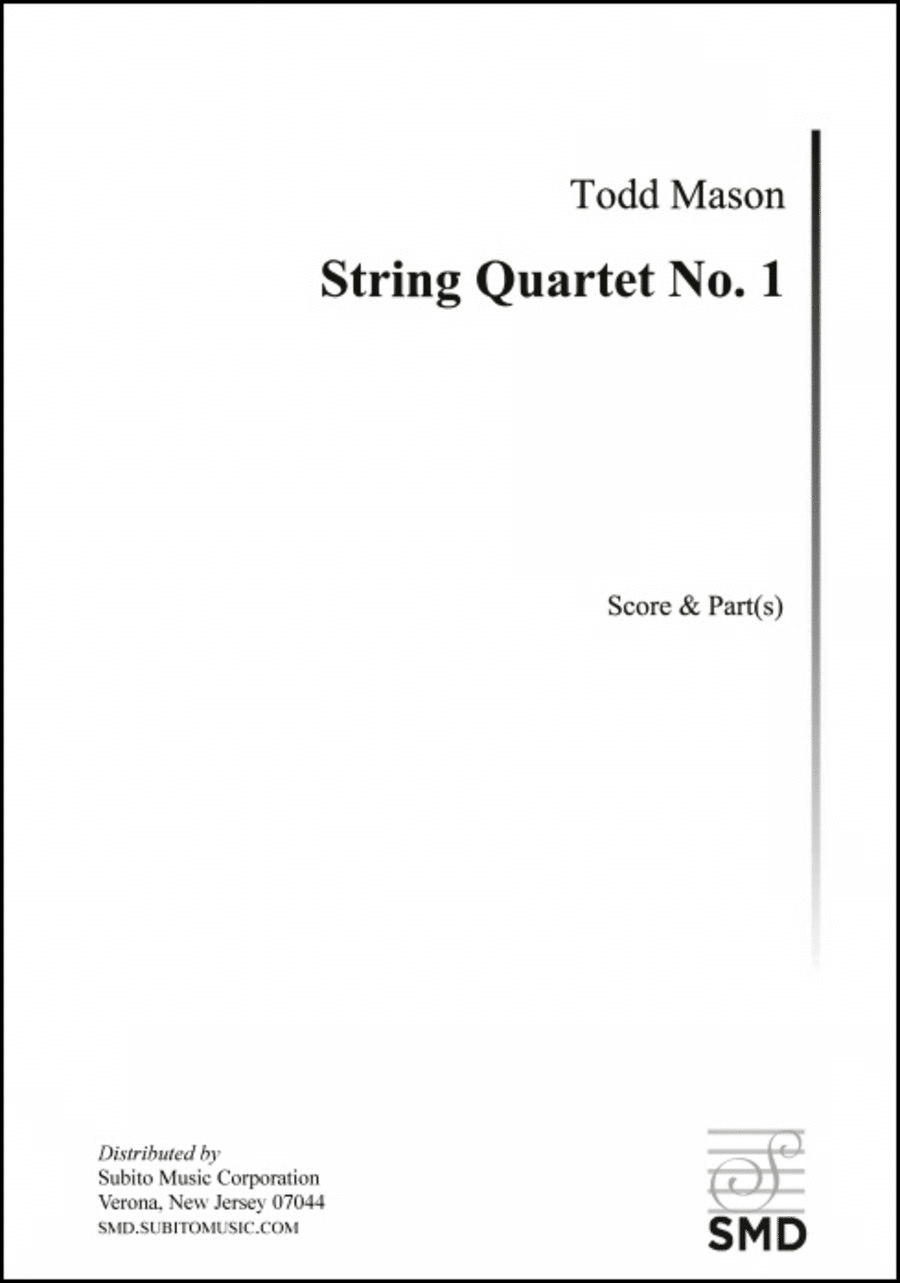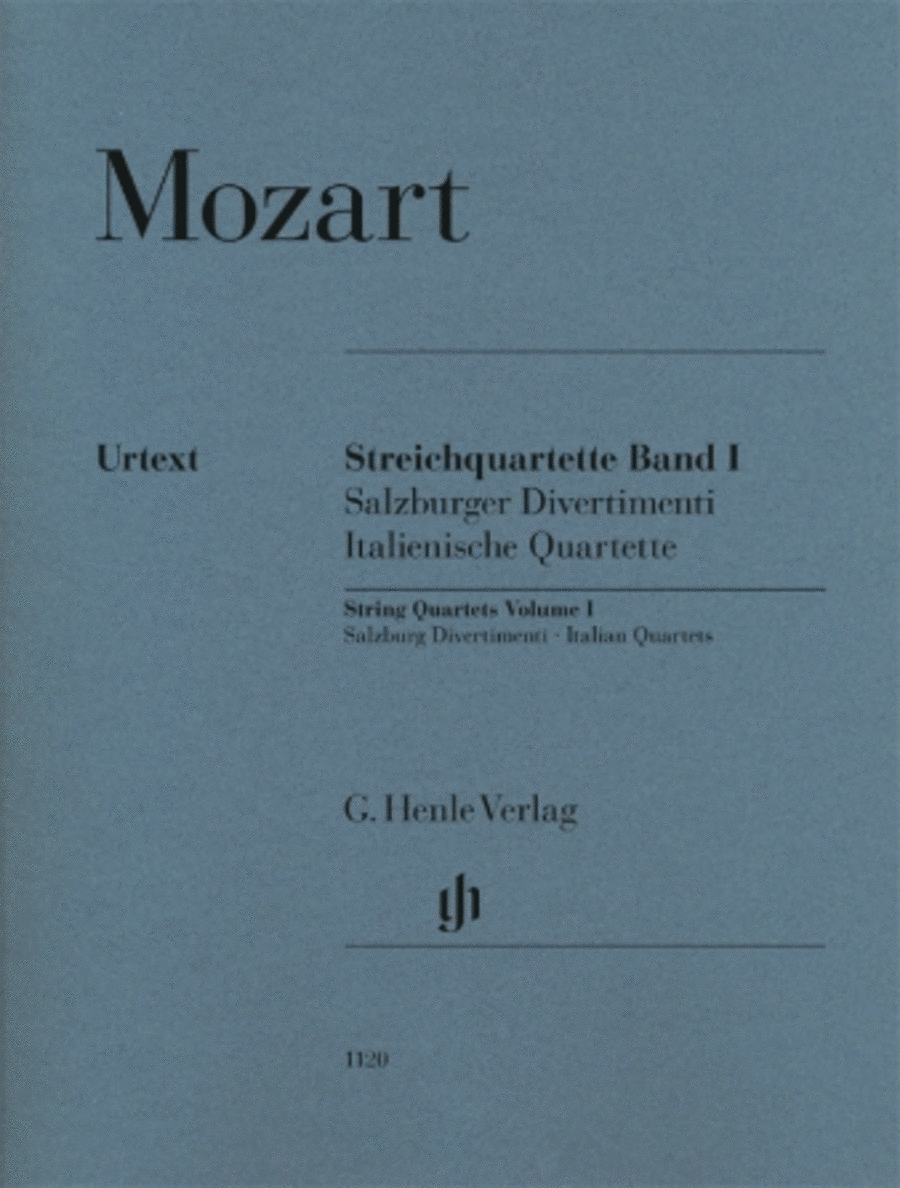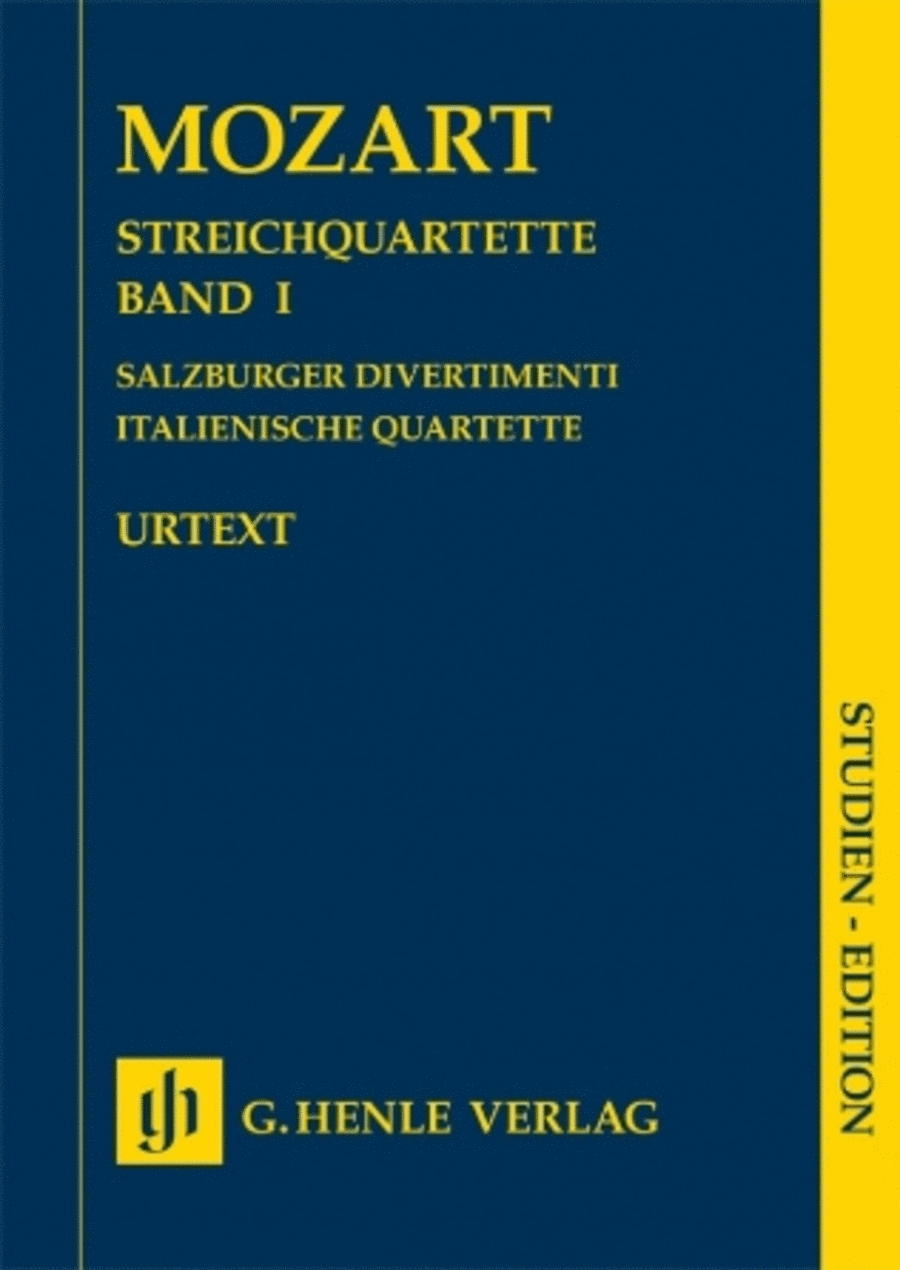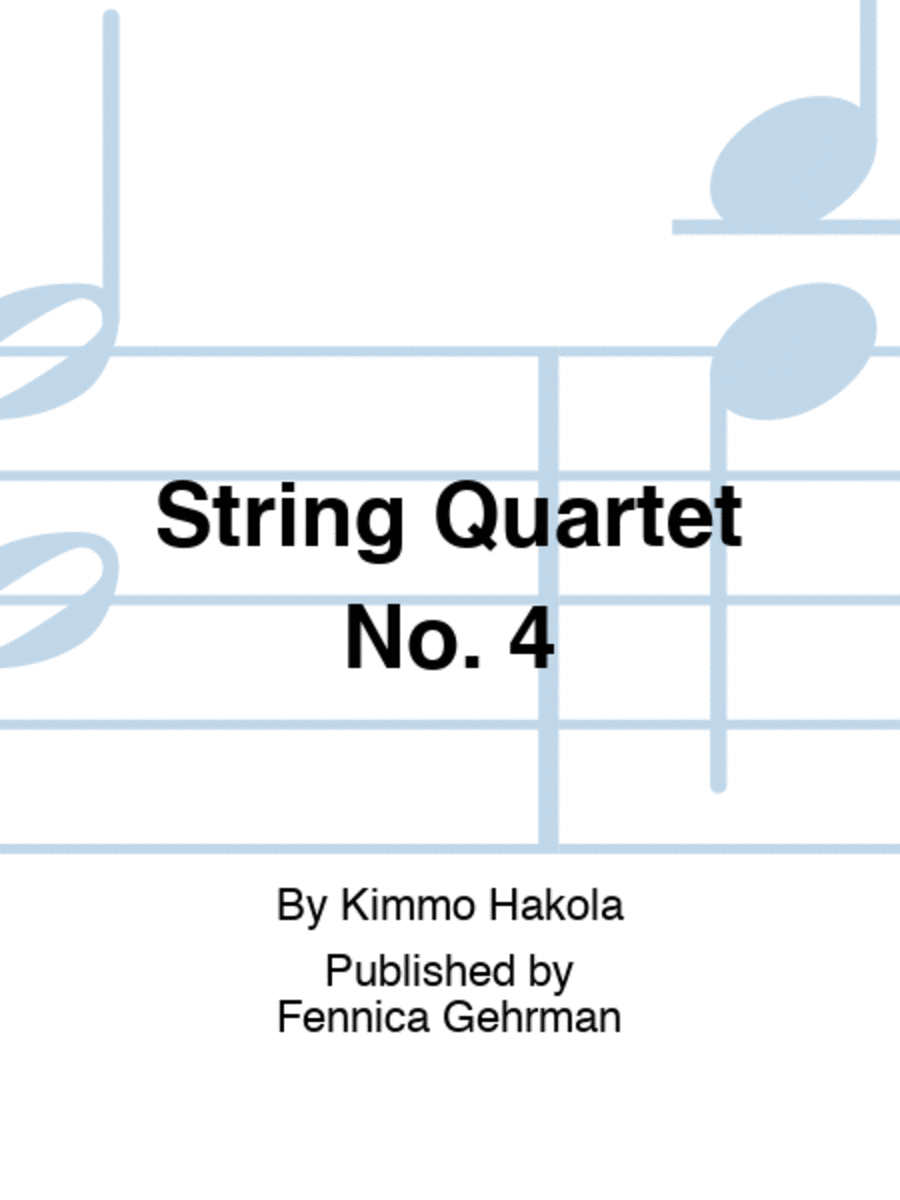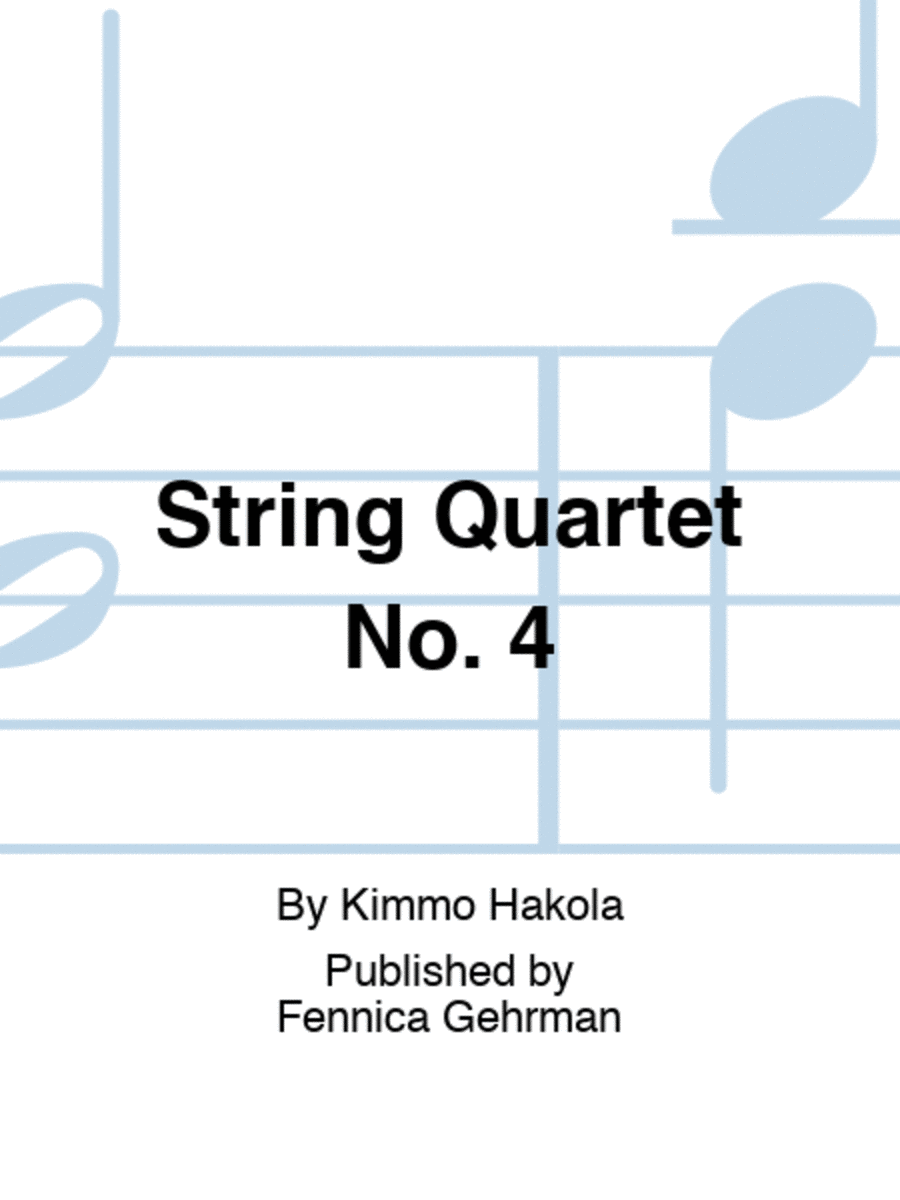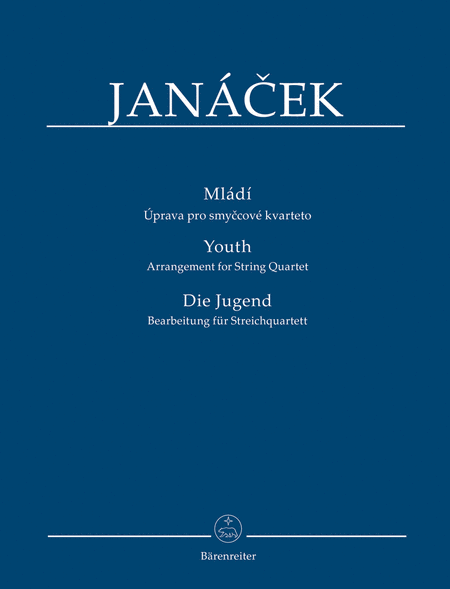String Quartet - Youthful Work (BACEWICZ GRAZYNA)35.10 EUR - Voir plus - Acheter
Délais: 3-5 joursInstrumentation : Editeur : Port minimal constaté chez ce vendeur : 2.90 EURVendeur, prix & stockPar BACEWICZ GRAZYNA. Grazyna Bacewicz realised at a very early age that her main purpose in life was to compose music. Already during the 1920s, as a student of Lódz Conservatoire, as part of her lessons in harmony and counterpoint, she made attempts at composing, in which she tried to resolve nagging technical problems and impart an artistically satisfying form to them. She grew up in an atmosphere of anti-romantic tumult and the emerging neoclassical style. She assimilated the main attributes of that current in a natural way: the need to forge logical formal constructs based on new harmonic principles, not determined by the major–minor system, and also a freedom in the shaping of textures, a fixed element of which was the combining of homophony with more or less strict polyphonic forms.
One example of such a strategy is the String Quartet from her student years, signed with the date 1929–1930, which the composer did not include in her official catalogue of works. In the first movement (Allegro moderato), one can distinguish two principal subjects, served in the form of the incomplete exposition of a fugue. The chromaticised first subject, with its strongly highlighted head motif, appears in the cello, with an answer coming four bars later in the first violin. After a short bridge, the first violin intones the second subject, of a different character (dolce), and the answer appears a bar later and an octave lower in the viola. Both subjects can be heard also in the closing coda, and the space between them is filled by counterpoints based largely on ostinato figures of various sorts – a technique that Bacewicz would hone to perfection in her later work.
The middle fughetta (Molto adagio), with a subject stated just once, and in only three parts (cello, first violin, viola), acts as an intermezzo.
The third movement (Allegro molto moderato) is a double fugue with strongly contrasting subjects. The first subject, in the form of a chromaticised melodic continuum, exposed by the cello, is initially shown with the traditional arrangement retained (answered by the viola and second violin at a fifth, and by the first violin an octave above). The second subject (energico) is a structure shaped by the opening repetition of a motif of perfect fifths, then octaves combined with staccato-tremolo figurations. As the work unfolds, the two subjects appear simultaneously in original and inverted form, coming together in the closing Cadenza in a uniform idea crowned by strong (fff) chords repeated towards the end. - Malgorzata Gasiorowska/ Répertoire / Quatuor à Cordes Contenu:
/ Répertoire / Ismn: 8388607
| Information vendeur : | LMI-Partitions | | Emplacement géographique : | France, Toulon | | Livraison : | Europe et USA | | Frais de ports : | |
|
ARTICLES SIMILAIRES
| Vendeurs Européens |
Vendeur Américain
Depuis le 1er juillet 2021, Sheet Music Plus n'expédie plus d'articles physiques dans les pays Européens! |
|
| String Quartet - Youthful
Work (BACEWICZ GRAZYNA)
Quatuor à cordes: 2 violons,
alto, violoncelle
PWM (Polskie Wydawnictwo Muzyczne)
Par BACEWICZ GRAZYNA. Grazyna Bacewicz realised at a very early age that her mai...(+)
Par BACEWICZ GRAZYNA. Grazyna Bacewicz realised at a very early age that her main purpose in life was to compose music. Already during the 1920s, as a student of Lódz Conservatoire, as part of her lessons in harmony and counterpoint, she made attempts at composing, in which she tried to resolve nagging technical problems and impart an artistically satisfying form to them. She grew up in an atmosphere of anti-romantic tumult and the emerging neoclassical style. She assimilated the main attributes of that current in a natural way: the need to forge logical formal constructs based on new harmonic principles, not determined by the major–minor system, and also a freedom in the shaping of textures, a fixed element of which was the combining of homophony with more or less strict polyphonic forms.
One example of such a strategy is the String Quartet from her student years, signed with the date 1929–1930, which the composer did not include in her official catalogue of works. In the first movement (Allegro moderato), one can distinguish two principal subjects, served in the form of the incomplete exposition of a fugue. The chromaticised first subject, with its strongly highlighted head motif, appears in the cello, with an answer coming four bars later in the first violin. After a short bridge, the first violin intones the second subject, of a different character (dolce), and the answer appears a bar later and an octave lower in the viola. Both subjects can be heard also in the closing coda, and the space between them is filled by counterpoints based largely on ostinato figures of various sorts – a technique that Bacewicz would hone to perfection in her later work.
The middle fughetta (Molto adagio), with a subject stated just once, and in only three parts (cello, first violin, viola), acts as an intermezzo.
The third movement (Allegro molto moderato) is a double fugue with strongly contrasting subjects. The first subject, in the form of a chromaticised melodic continuum, exposed by the cello, is initially shown with the traditional arrangement retained (answered by the viola and second violin at a fifth, and by the first violin an octave above). The second subject (energico) is a structure shaped by the opening repetition of a motif of perfect fifths, then octaves combined with staccato-tremolo figurations. As the work unfolds, the two subjects appear simultaneously in original and inverted form, coming together in the closing Cadenza in a uniform idea crowned by strong (fff) chords repeated towards the end. - Malgorzata Gasiorowska/ Répertoire / Quatuor à Cordes
Délais: 2-5 jours - En Stock Fournisseur | | |
| Youth
Quatuor à cordes: 2 violons,
alto, violoncelle
Barenreiter
This piece reflects Janácek's memories of childhood and youth in his native Huk...(+)
This piece reflects Janácek's memories of childhood and youth in his native Hukvaldy and the Augustinian Abbey in Brno. Kry?tof Maratka, a Czech composer resident in France and a great admirer of Janácek, has arranged the original version to produce a welcome addition to the string quartet repertoire.Youth for wind sextet, is a masterpiece from Janácek's late period (1924). Maratka has successfully managed to transform the concise winds' sound that give this work its unique flavour into the timbre of the strings, thereby creating a 'third string quartet? of the composer.- Janácek's wind sextet arranged for string quartet- Welcome addition to the string quartet repertoire- Foreword by the arranger (Cz/Eng/Ger) / Quatuor A Cordes
Délais: 2-5 jours - En Stock Fournisseur | | |
| Youth
Quatuor à cordes: 2 violons,
alto, violoncelle
Barenreiter
This piece reflects Janácek's memories of childhood and youth in his native Huk...(+)
This piece reflects Janácek's memories of childhood and youth in his native Hukvaldy and the Augustinian Abbey in Brno. Kry?tof Maratka, a Czech composer resident in France and a great admirer of Janácek, has arranged the original version to produce a welcome addition to the string quartet repertoire.Youth for wind sextet, is a masterpiece from Janácek's late period (1924). Maratka has successfully managed to transform the concise winds' sound that give this work its unique flavour into the timbre of the strings, thereby creating a 'third string quartet? of the composer.- Janácek's wind sextet arranged for string quartet- Welcome addition to the string quartet repertoire- Foreword by the arranger (Cz/Eng/Ger) / Quatuor A Cordes
Délais: 2-5 jours - En Stock Fournisseur | | |
| Double Concerto (Score
And Parts)
Piano Trio: Violon, Alto, Piano [Partition]
Chester
For Violin, Viola and Piano (Reduced from the orchestra version). Britten was so...(+)
For Violin, Viola and Piano (Reduced from the orchestra version). Britten was so remarkably prolific as a young composer that many of the works from his teens were put aside to await revision or completion as he rushed on to the next piece. This was particularly the case around the time of his Opus 1 Sinfonietta , composed in the summer of 1932, his second year as a student at the Royal College Of Music. The Sinfonietta was written (in less than three weeks) very soon after Britten had completed the first draft of the Double Concerto - but after finishing the Sinfonietta he went back to revise the Concerto's second movement. He started work on his Op.2 Phantasy for Oboe and String Trio a few weeks later. Although the Concerto follows the same three-movement pattern as the Sinfonietta , it is more ambitious in scale - and since the sketch is, unusually for Britten, complete in practically every detail, it is puzzling that he never made a full score of the work after finishing the composition, and seems to have made no attempt to get it performed. It is not clear if he had particular performers in mind (he was, of course, a Viola player, although he is not likely to have intended the part for himself). He showed the work to his composition teacher at the college, John Ireland, who, as Britten recorded in his diary, was 'pretty pleased' with it - but it is distinctly possible that his experience in rehearsing the Sinfonietta with a student orchestra in 1932 ('I have never heard such an appalling row!' reads another diary entry) discouraged him from going on to complete the Double Concerto in score. He was not to hear any of his orchestral works until the first performance of Our Hunting Fathers in 1936. In the absence of Britten's full score it was necessary for me to prepare the work from the sketch. But the instrumentation is so carefully indicated in the draft that the resulting score is not far from being 100% Britten - only between bars 70 and 74 of the slow movement did there seem to be any need to add anything significant to Britten's texture. The Double Concerto (Britten's manuscript title was 'Concerto In B Minor', but he referred to it in his diary, in characteristic shorthand, as '2ble Concerto') is the most recent addition to his corpus of works, mostly dating from Britten's youth and early maturity, that, since his death, have been revived after many years, or performed for the first time. Britten himself occasionally returned to his early works, and in his last years revised both the early String Quartet In D of 1931 and the opera Paul Bunyan . The Piano score published separately is not a reduction from the orchestral score, but a transcription of Britten's composition sketch, including his indications of instrumentation. The first performance of the Double Concerto was given at the 50th Aldeburgh Festival by Katherine Hunka and Philip Dukes, with the Britten-Pears Orchestra conducted by Kent Nagano, on June 15th 1997. -Colin Matthews / Violon, Alto Et Piano
Délais: 2-5 jours - En Stock Fournisseur | | |
| Elgar Essential Gold
Collection Piano
Piano seul [Partition] - Intermédiaire
Chester
The latest book in this popular series features the music of Sir Edward Elgar, i...(+)
The latest book in this popular series features the music of Sir Edward Elgar, in honour of his 150th birthday in 2007.<br>Includes solo-piano arrangements of Elgar's best-loved works, including selections from Sea Pictures, the Cello Concerto, Enigma Variations, Pomp and Circumstance March No. 1, and much more.<br>Arranged for intermediate solo piano. An essential addition to your piano library. / Classique / Partition /
Délais: En Stock
Plus que 1 ex. en stock, commandez vite ! | | |
| Classical Repertoire For
Recorder (PUSCOIU COSTEL)
Flûte à bec Soprano - Intermédiaire
Mel Bay
Par PUSCOIU COSTEL. Well-known classical works for recorder students at all leve...(+)
Par PUSCOIU COSTEL. Well-known classical works for recorder students at all levels of ability, adapted and arranged especially for the recorder. The works are drawn from all periods, including Baroque, Classical, Romantic and Modern. The author has carefully placed the melodies in the best keys for easy recorder. / Niveau : Intermédiaire / Classic - Solos / Recueil / Flûte à Bec Soprano
Délais: 2-5 jours - En Stock Fournisseur | |
|
|
|
| String Quartet - Youthful Work
Quatuor à cordes: 2 violons, alto, violoncelle [Conducteur et Parties séparées]
PWM (Polskie Wydawnictwo Muzyczne)
String Quartet SKU: BT.PWM12637 Composed by Grazyna Bacewicz. Classical. ...(+)
String Quartet SKU:
BT.PWM12637 Composed
by Grazyna Bacewicz.
Classical. Set (Score &
Parts). Composed 2021.
Polskie Wydawnictwo
Muzyczne #PWM12637.
Published by Polskie
Wydawnictwo Muzyczne
(BT.PWM12637).
$30.95 - Voir plus => AcheterDélais: 4 to 6 weeks | | | |
| Dabke (String Orchestra Score)
Orchestre à Cordes
Schirmer
Composed by Kareem Roustom. Young People's Concert, Youth Orchestra, Short Work....(+)
Composed by Kareem
Roustom. Young People's
Concert, Youth Orchestra,
Short Work. 21st Century,
Secular. Published by
E.C. Schirmer Publishing
(EC.LMP025).
$35.00 - Voir plus => AcheterDélais: 1 to 2 weeks | | | |
| String Quartet No. 1
Quatuor à cordes: 2 violons, alto, violoncelle [Conducteur et Parties séparées]
Subito Music
String Quartet SKU: SU.29120020 For String Quartet. Composed by To...(+)
String Quartet SKU:
SU.29120020 For
String Quartet.
Composed by Todd Mason.
Score & Parts. Subito
Music Corporation
#29120020. Published by
Subito Music Corporation
(SU.29120020).
String Quartet
No. 1 is a powerful
and harmonically dynamic
string quartet in four
movements. It mixes both
tonal and dissonant
musical landscapes in an
elegant way. The quartet
may also be experienced
as a kind of
coming-of-age story.
After the calm first
movement’s
confident simplicity of
youth, the second
movement reflects the
increasing complications
and conflicts of young
adulthood, with fraught
exploration, the
discovery of possible
romance, and new tensions
now replacing the
youthful calm. The third
movement reflects on
maturity and the
experiences of love and
loss, before the
finale—a set of
complex chromatic
fugues—evokes the
fight against fate and
time to achieve
one’s goals in
life. The
movement’s end
briefly recapitulates the
first movement,
suggesting that
ultimately life comes
full circle as we see the
totality of our
experience. As LA Opus
music critic, John
Stodder, said about this
work, The protagonist
discovers the presence of
life's purpose. String
Quartet Duration: 19'
Composed: 2019 Published
by: Todd Mason. $70.00 - Voir plus => AcheterDélais: 2 to 3 weeks | | | |
| String Quartets Volume 1 (Italian Quartets, Salzburg Divertimenti)
Quatuor à cordes: 2 violons, alto, violoncelle
G. Henle
String Quartet (Parts) SKU: HL.51481120 Set of Parts. Composed by ...(+)
String Quartet (Parts)
SKU: HL.51481120
Set of Parts.
Composed by Wolfgang
Amadeus Mozart. Edited by
Wolf-Dieter Seiffert.
Ensemble. Classical.
Softcover. G. Henle
#HN1120. Published by G.
Henle (HL.51481120).
UPC: 196288034773.
9.0x12.0x0.625
inches. This volume
brings together Mozart's
youthful attempts at this
later so central genre of
the string quartet: the
astonishing “Lodi
Quartet†K. 80 by
the only
fourteen-year-old
composer, the three
“Quartet-Divertimen
ti†K. 136-138
which are also readily
played by chamber
orchestras, and Mozart's
first true string-quartet
cycle K. 155-160 which
was composed during his
third (north-)Italian
journey in 1772/73.
Mozart's cleanly written
scores of all the
compositions have been
preserved so that the
edition stands on a
secure foundation. In his
informative commentary,
Wolf-Dieter Seiffert, the
experienced Mozart editor
at G. Henle Publishers,
devotes a separate,
comprehensive explanatory
section to the well-known
articulation problem
“dot or
wedge.†The Armida
Quartet provided artistic
input for this
edition.
About Henle
Urtext
What I can expect from
Henle Urtext
editions:
- error-free, reliable
musical texts based on
meticulous musicological
research - fingerings and
bowings by famous artists
and pedagogues
- preface in 3
languages with
information on the
genesis and history of
the work
- Critical Commentary
in 1 – 3 languages
with a description and
evaluation of the sources
and explaining all source
discrepancies and
editorial
decisions
- most beautiful music
engraving
- page-turns, fold-out
pages, and cues where you
need them
- excellent print
quality and
binding
- largest Urtext
catalogue
world-wide
- longest Urtext
experience (founded 1948
exclusively for Urtext
editions)
$38.95 - Voir plus => AcheterDélais: 24 hours - In Stock | | | |
| String Quartets Vol. 1 (Salzburg Divertimenti, Italian Quartets)
Quatuor à cordes: 2 violons, alto, violoncelle
G. Henle
String Quartet (Study Score) SKU: HL.51487120 Study Score. Compose...(+)
String Quartet (Study
Score) SKU:
HL.51487120 Study
Score. Composed by
Wolfgang Amadeus Mozart.
Edited by Wolf-Dieter
Seiffert. Study Score.
Classical. Softcover. 138
pages. G. Henle #HN7120.
Published by G. Henle
(HL.51487120). UPC:
196288034353.
6.75x9.5x0.395
inches. This volume
brings together Mozart's
youthful attempts at this
later so central genre of
the string quartet: the
astonishing “Lodi
Quartet†K. 80 by
the only
fourteen-year-old
composer, the three
“Quartet-Divertimen
ti†K. 136-138
which are also readily
played by chamber
orchestras, and Mozart's
first true string-quartet
cycle K. 155-160 which
was composed during his
third (north-)Italian
journey in 1772/73.
Mozart's cleanly written
scores of all the
compositions have been
preserved so that the
edition stands on a
secure foundation. In his
informative commentary,
Wolf-Dieter Seiffert, the
experienced Mozart editor
at G. Henle Publishers,
devotes a separate,
comprehensive explanatory
section to the well-known
articulation problem
“dot or
wedge.†The Armida
Quartet provided artistic
input for this
edition.
About Henle
Urtext
What I can expect from
Henle Urtext
editions:
- error-free, reliable
musical texts based on
meticulous musicological
research - fingerings and
bowings by famous artists
and pedagogues
- preface in 3
languages with
information on the
genesis and history of
the work
- Critical Commentary
in 1 – 3 languages
with a description and
evaluation of the sources
and explaining all source
discrepancies and
editorial
decisions
- most beautiful music
engraving
- page-turns, fold-out
pages, and cues where you
need them
- excellent print
quality and
binding
- largest Urtext
catalogue
world-wide
- longest Urtext
experience (founded 1948
exclusively for Urtext
editions)
$25.95 - Voir plus => AcheterDélais: 24 hours - In Stock | | | |
| String Quartet No. 4
Quatuor à cordes: 2 violons, alto, violoncelle [Set de Parties séparées]
Fennica Gehrman
String quartet SKU: FG.55011-498-2 Composed by Kimmo Hakola. Parts. Fenni...(+)
String quartet SKU:
FG.55011-498-2
Composed by Kimmo Hakola.
Parts. Fennica Gehrman
#55011-498-2. Published
by Fennica Gehrman
(FG.55011-498-2). ISBN
9790550114982. Kimm
o Hakola's String Quartet
No. 4 op. 95 (2016) was
commissioned by the
Kimito Island Music
Finland and it's
dedicated to the Meta4
Quartet. In composer's
words, it is the
floundering, playful, if
necessary defiantly
dramatic, surprising,
capricious and
unrestrained tour de
force of a youthful
entity.Kimmo Hakola has
gone through a number of
styles and influences in
his career as a composer,
his idiom expanding at
times to embrace
Romanticism, Orientalism
and klezmer. He has
attained international
recognition with an
output that spans various
genres from intimate solo
works to full-length
operas such as La Fenice
(2011) commissioned by
the Savonlinna Opera
Festival. Many of his
works are expansive and
epic: his Piano Concerto
(1996), for instance,
clocks in at 55 minutes.
Hakola says that he sees
music as drama. His
dramas explore almost
Shakespearean extremes,
from moments of raging
'sound and fury' and
violent battles to quiet
moments of meditation and
heart-rending
monologues. $40.95 - Voir plus => AcheterDélais: 4 to 6 weeks | | | |
| String Quartet No. 4
Quatuor à cordes: 2 violons, alto, violoncelle [Conducteur]
Fennica Gehrman
String quartet SKU: FG.55011-497-5 Composed by Kimmo Hakola. Score. Fenni...(+)
String quartet SKU:
FG.55011-497-5
Composed by Kimmo Hakola.
Score. Fennica Gehrman
#55011-497-5. Published
by Fennica Gehrman
(FG.55011-497-5). ISBN
9790550114975. Kimm
o Hakola's String Quartet
No. 4 op. 95 (2016) was
commissioned by the
Kimito Island Music
Finland and it's
dedicated to the Meta4
Quartet. In composer's
words, it is the
floundering, playful, if
necessary defiantly
dramatic, surprising,
capricious and
unrestrained tour de
force of a youthful
entity.Kimmo Hakola has
gone through a number of
styles and influences in
his career as a composer,
his idiom expanding at
times to embrace
Romanticism, Orientalism
and klezmer. He has
attained international
recognition with an
output that spans various
genres from intimate solo
works to full-length
operas such as La Fenice
(2011) commissioned by
the Savonlinna Opera
Festival. Many of his
works are expansive and
epic: his Piano Concerto
(1996), for instance,
clocks in at 55 minutes.
Hakola says that he sees
music as drama. His
dramas explore almost
Shakespearean extremes,
from moments of raging
'sound and fury' and
violent battles to quiet
moments of meditation and
heart-rending
monologues. $40.95 - Voir plus => AcheterDélais: 4 to 6 weeks | | | |
| Youth (Arranged for String Quartet)
Quatuor à cordes: 2 violons, alto, violoncelle [Conducteur d'étude / Miniature] - Intermédiaire
Barenreiter
Composed by Leos Janacek (1854-1928). Arranged by Krystof Maratka. Stapled. S...(+)
Composed by Leos Janacek
(1854-1928). Arranged by
Krystof Maratka. Stapled.
Study score. Baerenreiter
Verlag #TP00521.
Published
by Baerenreiter Verlag
$32.95 - Voir plus => AcheterDélais: 24 hours - In Stock | | |
|
|
|
